
Ctenophorus is a genus of lizards, also known as comb-bearing dragons, that contains the most diverse group of dragon lizards in Australia. It is the largest group of Australian lizards and it has an extensive radiation in the arid zones. Many of these have been grouped by a similar morphology. The informal names and groupings within this genus — rock, crevice-, ground, sand-, and bicycle-dragon — are named after the mythological creature, the dragon.
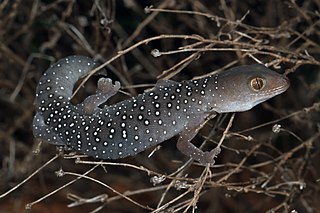
Strophurus elderi, also known as the jewelled gecko, is a species of gecko, a lizard in the family Diplodactylidae. The species is endemic to Australia.
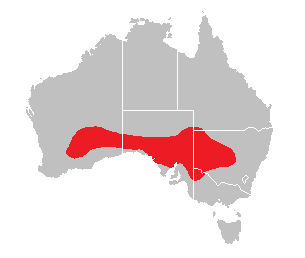
Ctenophorus fordi, commonly known as the Mallee dragon, Mallee military dragon, or Mallee sand-dragon, is a species of agamid lizard occurring in the arid parts of southern Australia.

Ctenophorus isolepis, commonly known as the military dragon, central military dragon or military sand dragon, is a species of agamid lizard occurring in the arid parts of central and western Australia.

Ctenophorus rubens, commonly known as the reddening sand-dragon or rufus sand dragon, is a species of agamid lizard occurring in the arid sandy areas of shrublands and spinifex of the Exmouth Gulf and the adjacent interior of Western Australia, with an isolated population also occurring in the sand dunes south of Hamelin Pool, Western Australia. It was formerly considered to be a subspecies of C. isolepis.

Ctenophorus adelaidensis, commonly known as the Western heath dragon is a species of agamid lizard occurring in sandplains with heath and banksia along the lower coast of Western Australia, between Kalbarri and Perth. Adults are grey in colour, with dark blotches. They are relatively slow compared to other Ctenophorus species, preferring to scuttle rather than sprint.
Ctenophorus butlerorum, commonly known as the shark bay heath dragon or butler's dragon is a species of agamid lizard occurring in dunes and sandplains of the mid-west coast of Western Australia between Shark Bay and Kalbarri.
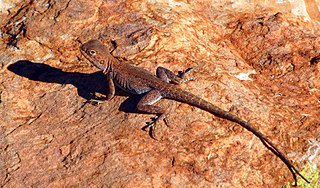
Ctenophorus caudicinctus, commonly known as the Ring-tailed dragon or Ring-tailed Bicycle-dragon is a species of agamid lizard occurring in rocky ranges and outcrops of northern and central Australia.
Ctenophorus chapmani, commonly known as the Southern Heath dragon, Bight Heath Dragon or Chapman's Dragon is a species of agamid lizard occurring in sandplains with heath or Mallee across southern Australia.
Ctenophorus clayi, commonly known as the black-collared dragon or black-shouldered ground-dragon is a species of agamid lizard occurring in red sand-ridges with spinifex in the central and western deserts of Australia, with an isolated population existing in North West Cape in Western Australia.
Ctenophorus cristatus, commonly known as the Crested dragon, Bicycle dragon or Crested Bicycle-dragon is a species of agamid lizard occurring in semi-arid woodlands in south-western Australia.
Ctenophorus femoralis, commonly known as the Long-tailed Sand dragon is a species of agamid lizard occurring on spinifex covered sand-ridges and sand-plains on the arid mid-western coast of Western Australia.
Ctenophorus maculatus, commonly known as the spotted military dragon, spotted dragon, or spotted sand-dragon is a species of agamid lizard occurring in semi-arid to arid shrublands and hummock grasslands of Western Australia and a small part of South Australia.
Ctenophorus mckenziei, commonly known as the dwarf bicycle-dragon or McKenzie's dragon, is a species of lizard in the family Agamidae. The species is endemic to Australia.
Ctenophorus nguyarna, commonly known as the Lake Disappointment dragon is a species of agamid lizard occurring in low samphire shrubs fringing the remote Lake Disappointment in Western Australia.
Ctenophorus parviceps, commonly known as the Gnaraloo Heath dragon or North-western Heath dragon is a species of agamid lizard occurring in pale coastal sands and shell grit with open heaths and beach spinifex, between the North West Cape and Carnarvon, Western Australia and on Bernier Island.
Ctenophorus rufescens, commonly known as the Rusty dragon or Rusty-crevice dragon is a species of agamid lizard occurring in granite outcrops featuring open expanses strewn with exfoliated rock, in arid north-western South Australia, south-western Northern Territory and adjacent Western Australia.
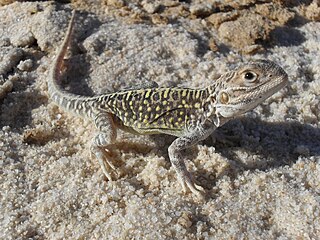
Ctenophorus salinarum, commonly known as the Claypan dragon or Saltpan Ground-dragon is a species of agamid lizard occurring in arid to semi-arid chenopod shrublands around salt lakes and claypans and in adjacent sandy heaths in southern Western Australia.
Ctenophorus tjantjalka, also known as the ochre dragon, is a species of agamid lizard occurring on low, weathered, crumbling outcrops and stony hills in arid South Australia, from the Painted Hills north-west to the base of the Everard Ranges.
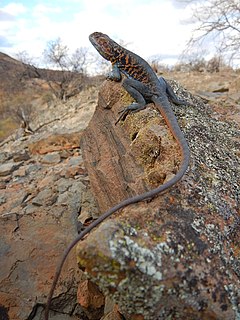
Ctenophorus vadnappa, commonly known as the red-barred dragon or red-barred crevice-dragon is a species of agamid lizard occurring in rocky outcrops and ranges in semi-arid to arid South Australia, from the northern Flinders Ranges to hills north of Lake Torrens.









